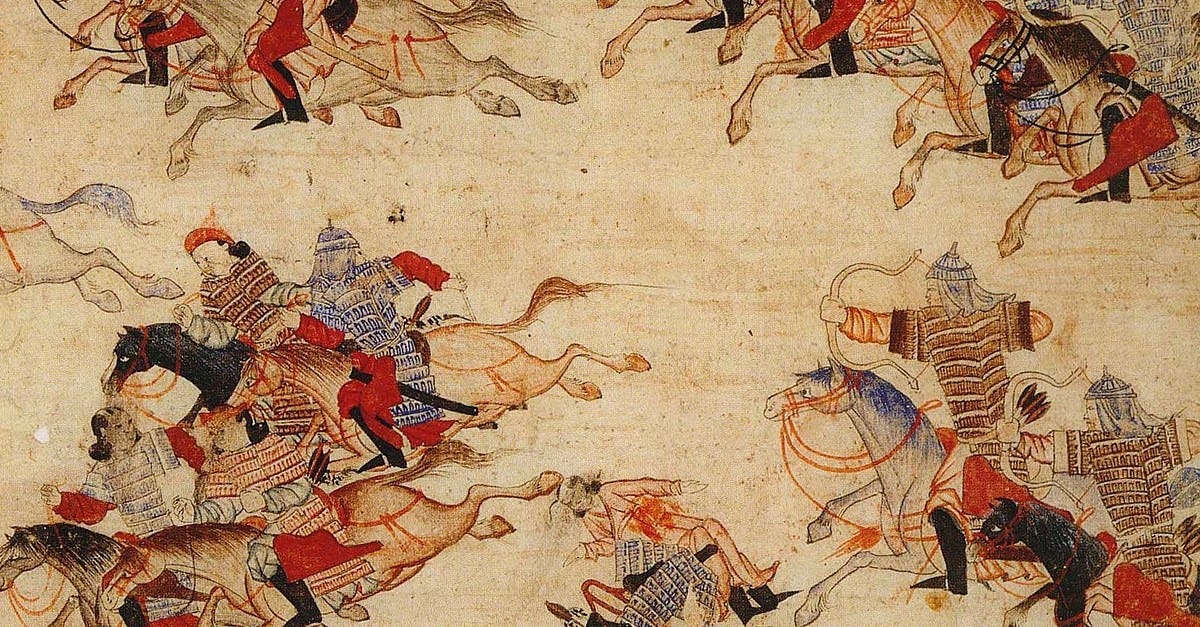Steppes To Success: A Look Into History's Greatest Meritocracy & The Lessons It Can Teach Us Today
Meritocracy seems like one of those systems that should be ubiquitous – throughout both history and in the present. After all, it makes basic sense that those who are best at what they do get promoted. But instances of meritocracy in historical organizations are relatively few. Even in groups where competence would be a literally a life and death matter – like the military – leaders throughout history have tended to favor those with money or lineage rather than those with tactical acumen.
Many would point out that things are not that different today. For example, colleges routinely have different standards for legacies, recruited athletes, children of donors, and minorities – the specific stats are in the footnotes.1 The focus on the benefit for students of color has been a particular lightning rod of controversy after the Supreme Court declared that affirmative action was unconstitutional.2
Companies and organizations are also facing criticism for refusing to prioritize talent. Though nepotism and “connections” certainly factor into this, recent controversy has focused on DEI, or diversity, equity, and inclusion. One of the biggest examples of DEI is Elizabeth Warren. Warren touted herself as being part Native American and secured a professorship at Harvard Law. Though the university claims she received the position on merit, every single professor at Harvard Law had graduated from a top ten law school, and a majority graduated from Harvard itself. Warren’s alma mater, Rutgers Law School, is not even in the top 100. Of course, Warren was later discovered to have grossly exaggerated her heritage, and ironically has less Native American blood than the average American.
But DEI has come under attack, just like affirmative action. Elon Musk recently tweeted that “DEI must DIE,” and companies have begun to either downsize or even eliminate their commitment to the philosophy. Critics have claimed that this will hurt applicants of color, which in turn gets criticized for insinuating that minorities would not be able to get positions on their own merit.
Looking through the annals of history, it is hard to find an answer as to whether meritocracy does hurt diversity – after all, the multicultural world of today is something recent and unprecedented. However, there is at least one example where a strong commitment to meritocracy ended up elevating disenfranchised candidates – who in turn helped establish one of the world’s most successful empires, that of Genghis Khan.
Khan’s Generals
Born in 1162 in what is now Mongolia, Genghis Khan rose to power by uniting various Mongol tribes under his leadership through a combination of diplomacy and military prowess. Though part of this was undeniably due to his strength as a strategist and tactician, another part was his dedication to meritocracy, which allowed talented commanding officers to advance through the ranks. As summarized by Stephen Pow in The Journal of the Royal Asiatic Society:
“Chinggis Khan's victories over the most powerful states in Asia in the early years of the empire cannot be completely ascribed to the superiority of Mongol cavalry or the use of steppe tactics such as feigned retreats which were not actually Chinggisid innovations. Rather, his successes often resulted from his tendency to promote men to high command based on demonstrated ability rather than birth, which resulted in experienced, loyal officers who owed their promotions to the khan.”3
Of these experienced and loyal officers, three men, Subutai, Jebe, and Muqali, stand above the rest as Genghis Khan’s most trusted and most brilliant generals. True to form, all the men have fascinating backstories – from blacksmith to enemy soldier to slave.
The Blacksmith With An Iron Mind
Subutai, also known as Subotai or Subedei, is widely regarded as one of the most brilliant military strategists and commanders in history. As the chief military strategist and trusted general of Genghis Khan, Subutai played a pivotal role in the rapid expansion of the Mongol Empire during the 13th century. He was born around 1175 in Mongolia as part of the Uriankhai tribe. As a young boy, he was a commoner whose father was a blacksmith; some reports claim that he was training to become a blacksmith as well. However, at 14-years-old, he decided instead to join the service of Genghis Khan, then known as Temujin. Because of his age, Subutai was given the lowly job of Genghis Khan’s doorman. However, during his training, Subutai’s talents quickly became apparent, and he rose through the ranks as a military officer to become a general before he was even 25-years-old. Subutai's military genius was instrumental in the success of numerous Mongol campaigns. Some of his most notable achievements include the Conquest of Khwarezm, the Battle of Kalka River, and the invasion of Western Xia in China. However, he is arguably most well known for coordinating the defeats of both the Hungarian and Polish armies, which occurred within the span of just two days of one another.4
It is difficult for a short (well, shortish) article like this one to properly emphasize Subutai’s brilliance or his importance to Genghis Khan. According to British war historian B.H. Liddell Hart in Great Captains Unveiled, “the strategical [sic] ability of [Subutai and Genghis Khan] is matched in history only by that of Napoleon.”5 But one statistic perhaps says it best: he conquered more territory than any other general in history, amounting to 32 nations and 65 battles.
The Original Arrow, Pre DC Comics
Jebe, also known as Jebei, Zev, Jirqo'adai or Zurgaadai, grew up in a nomadic Mongolian tribe. He was a skilled horseman and an adept archer, two traits that would prove invaluable in his future military career. As a young warrior, Jebe was part of a Taichi'ud contingent that opposed Genghis Khan during his early campaigns of unification. In 1204, Jebe took part in the Battle of Thirteen Sides against Genghis Khan. According to The Secret History of the Mongols, Jebe shot an arrow at Genghis Khan and managed to strike him in the neck, imparting a nearly fatal blow. After Genghis Khan’s victory, the Mongol leader faced the enemy soldiers and asked who had struck him. Jebe not only confessed to the act, but also stated that Genghis Khan had the authority to execute him.
But Genghis Khan had other ideas. Impressed with Jebe’s skill at archery, he instead recruited the young warrior and even gave him his aforementioned name, which translates to “arrow” from Mongolian.
Jebe went on to various military successes, often while paired with Subutai. For example, he fought successfully against the Jin Dynasty in China, participated in The Battles of Khwarezm and Kalka River, and the Kuchlung tribes. Unfortunately, not much is known about Jebe after 1223. He seems to have “disappeared,” though historians believe he may have been captured following the battle of the Kalka River.
However, it is possible that the mysterious circumstances surrounding his death are evidence of the respect he earned. As noted by Pow, “The silence and ambiguity surrounding Jebe's fate in pro-Mongol sources of the thirteenth century can perhaps be explained by a taboo surrounding the disgraceful circumstances of his capture and execution.”6
From Slave to Master and Commander
Muqali was born into the Naiman tribe, and his early life was marked by the turbulent social and political landscape of the Mongolian steppes. At some point during his youth, he was captured and enslaved. The circumstances of his capture and enslavement are not extensively documented, but it was not uncommon for individuals in the Mongolian steppe societies to be taken as slaves during times of conflict or raids.
As a slave, Muqali would have endured the hardships and challenges associated with servitude. However, his fate took a significant turn when he was later liberated or escaped from captivity and joined the service of Genghis Khan. Once Muqali aligned himself with Genghis Khan's cause, his skills as a military strategist and commander quickly became evident. He played pivotal roles in several key campaigns and demonstrated remarkable loyalty to Genghis Khan and his successors. He was particularly instrumental in Genghis Khan’s campaigns in China, serving as the military leader’s second-in-command. After Genghis Khan departed to focus on central Asia, Muqali remained and was given the position of Viceroy of China.
In 1223, the same year as Jebe’s death, Muqali fell ill and died in a camp along the Yellow River. On his deathbed, he sent a message to Genghis Khan: “Tell him I have never been defeated.”7
Conclusion
Normally, we here at HR&R strive to compare historical events and their similarities to those today. This article admittedly deviates by examining not what is happening today, but what should happen and what looks to be in the works. For example, just yesterday was the deadline for Renew Harvard, an initiative backed by alumni Bill Ackman and Mark Zuckerberg which hopes to nominate new blood to Harvard’s Board of Overseers and refocus the university’s priorities to “free speech and academic standards.”8
When societies have implemented a system of meritocracy, they have flourished: take Peter the Great’s Russia, Napoleon’s charge of France, and the aforementioned Mongol Empire. Moreover, as seen in the example of Genghis Khan, meritocracy is not the enemy of diversity, as some have claimed. Rather it abets it, perhaps making it, ironically, the best kind of DEI initiative of all.
Recruited athletes for Harvard’s class of 2025 had an average SAT score of 1397, compared to 1501 for non-athletes. Legacy students actually have higher SAT and ACT scores relative to the student body. Though no information is available on the scores of donor’s children, The Harvard Crimson reported that those on the ‘dean’s list,’ a list of students whose families would be potential donors, had an admit rate of around 42%. Stats on racial gap scores are in footnote 2.
https://nypost.com/2023/06/29/supreme-court-affirmative-action-case-showed-astonishing-racial-gaps/
https://www.jstor.org/stable/26187330?read-now=1&seq=1#page_scan_tab_contents
At this time, Subutai was fighting for the Mongol Empire, as Genghis Khan had died by that point.
https://www.armyupress.army.mil/Portals/7/military-review/Archives/English/Dir-Select/genghis-khan-july-1986.pdf
https://www.jstor.org/stable/26187330?read-now=1&seq=1#page_scan_tab_contents
Mongols by Rupert Matthews: https://www.google.com/books/edition/Mongols/3yKDDwAAQBAJ?hl=en&gbpv=1&dq=muqali+deathbed+never+been+defeated&pg=PT74&printsec=frontcover]
https://renewharvard.com/





